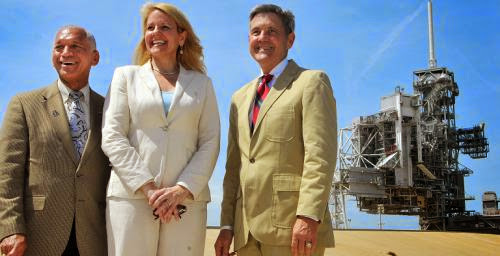skip to main |
skip to sidebar
A powerful new SpaceX rocket could blast off from Kennedy Space Center early in 2015, nearly four years after a shuttle last roared from the same pad. The company on Monday signed a 20-year lease of historic pad 39A, the launching point for the Apollo moon landings and numerous shuttle missions. "I promise everybody, we're going to make great use of this pad," said Gwynne Shotwell, SpaceX president and chief operating officer. NASA Administrator Charlie Bolden and KSC Director Bob Cabana joined Shotwell at the pad to announce the agreement moments after they signed it, beginning the pad's "new mission as a commercial launch site," Bolden said.SpaceX hopes to launch its first heavy-lift Falcon rocket from KSC in the first quarter of next year, a mission previously expected to launch from California.And if later this year SpaceX wins a NASA contract to launch astronauts to the International Space Station, those missions also would depart from KSC by 2017.The lease agreement is the most significant development yet in NASA's effort to transform KSC into a "multi-user" center supporting both government and commercial operations.NASA has already transferred three former shuttle hangars to new tenants, for assembly of a commercial crew capsule and operation of a classified military space plane program.The shuttle runway is the next major facility awaiting an agreement, with Space Florida negotiating to take over operations that could include horizontal launches and landings. Gwynne Shotwell speaks during the ceremony. (Photo: Craig Rubadoux, FLORIDA TODAY)"We continue to enable commercial operations from the Cape, allowing the use of national assets that would otherwise sit empty and decay," Cabana said.For its own exploration program, NASA only needs launch pad 39B to the north. An uncrewed first launch of the agency's Space Launch System rocket is planned from there in 2017.NASA sought to lease 39A to keep it active and save more than 1 million annually in maintenance costs. As part of the lease, SpaceX takes over pad operation and maintenance costs.The agency in December chose to negotiate a deal with SpaceX instead of Blue Origin, largely because SpaceX would be ready to use the pad quickly.Some members of Congress criticized the process, arguing that the unique, taxpayer-funded infrastructure should be made available to multiple launch companies, as Blue Origin preferred.NASA determined that was not realistic in the near term, and said pad 39B would also be available for commercial use.Architects and engineers have already spent months studying how to adapt the pad for launches of Falcon rockets and Dragons carrying crews.SpaceX plans to build a hangar nearby from which rockets would roll out horizontally and be raised to the vertical position on the pad. That's similar to how the company operates at Cape Canaveral Air Force Station's Launch Complex 40, which has launched International Space Station resupply missions and commercial satellites.Shotwell said SpaceX would install new instrumentation and some new plumbing at 39A.More details are to come, but the overhaul likely won't be as significant as at pad 39B, where NASA dismantled the fixed and rotating shuttle service towers."There will be some modification to (pad 39A), but the historic elements we obviously are leaving," Shotwell said.She said SpaceX wanted to launch its first Falcon Heavy - billed as the world's most powerful rocket, with 3.9 million pounds of thrust at liftoff - in the first half of next year, hopefully in the first quarter. Commercial missions would follow.Shotwell, one of SpaceX's first employees when Elon Musk started the company in 2002, said she was nearly speechless."I'd like to give a pep talk to all the folks that will be out here working on this pad, to make sure they understand how precious this is and respect it," Shotwell said.Credit: floridatoday.com



